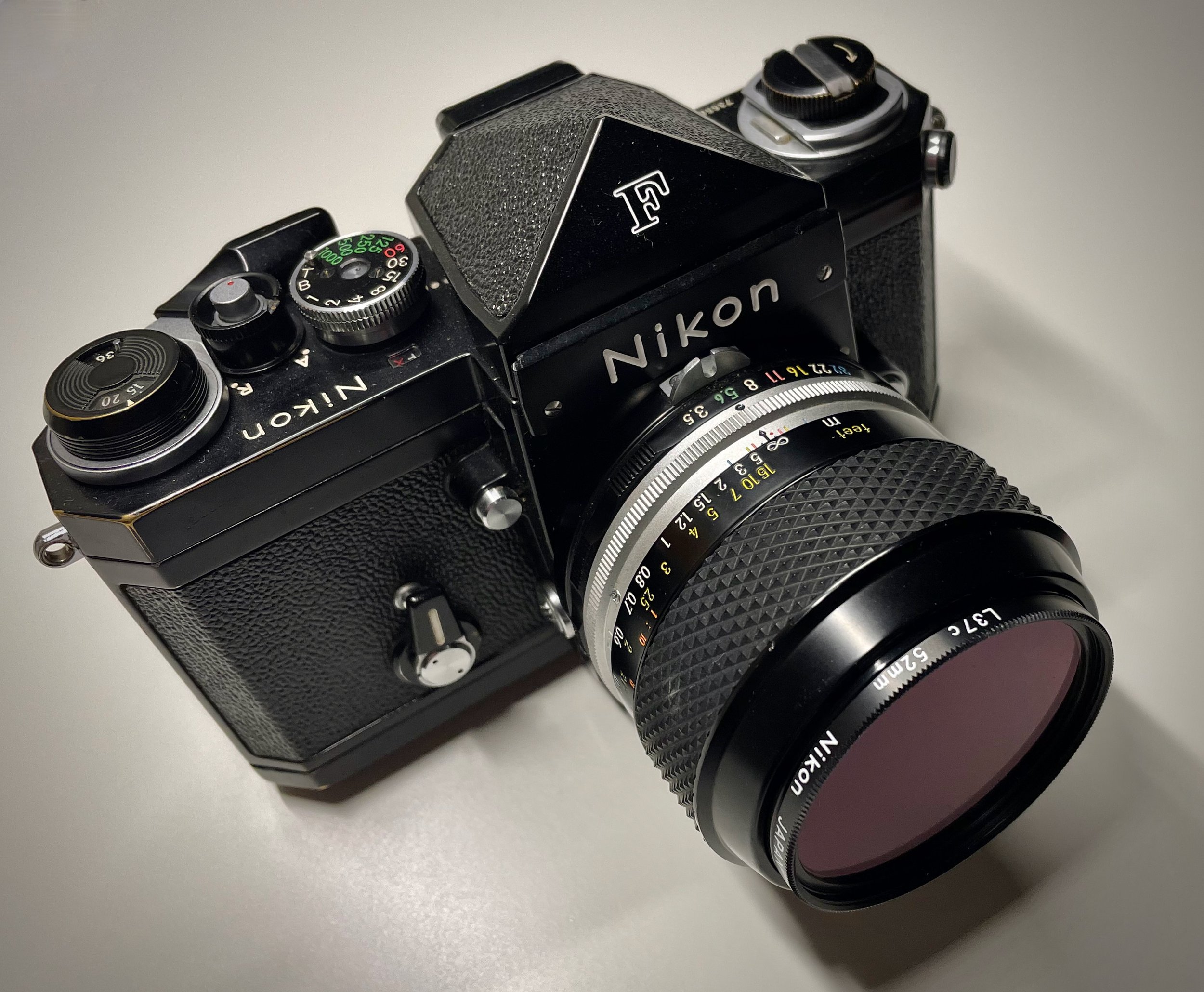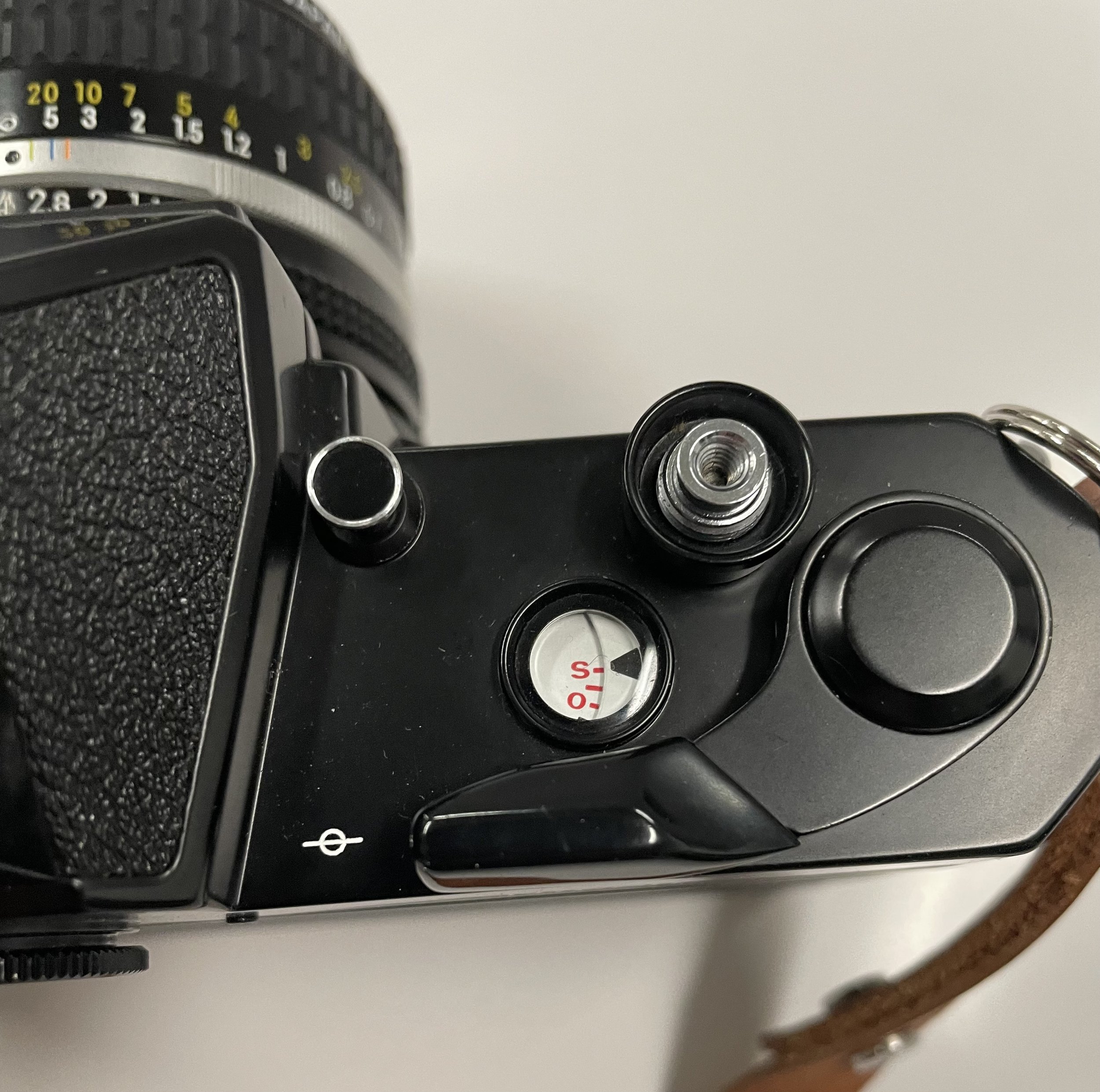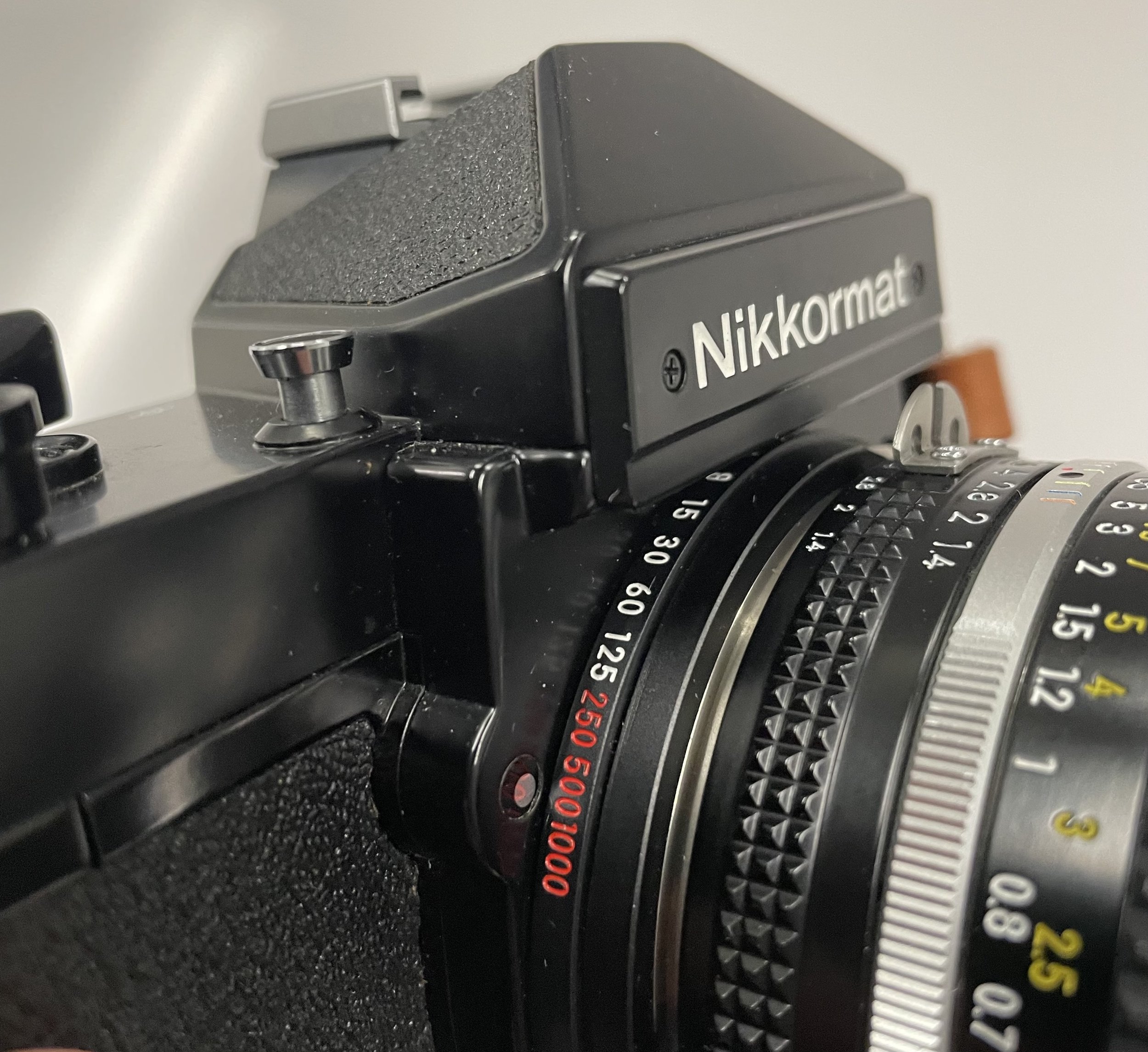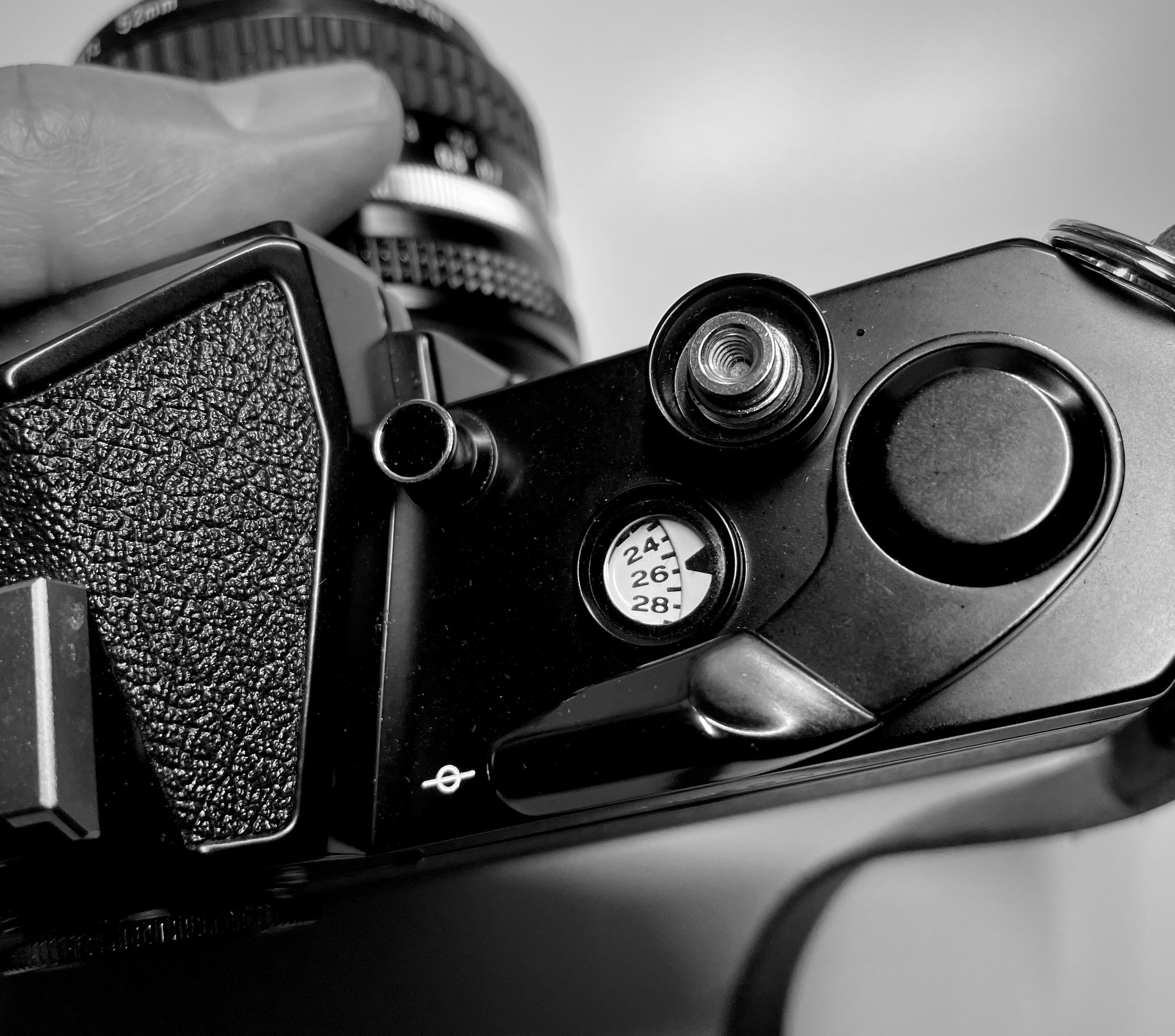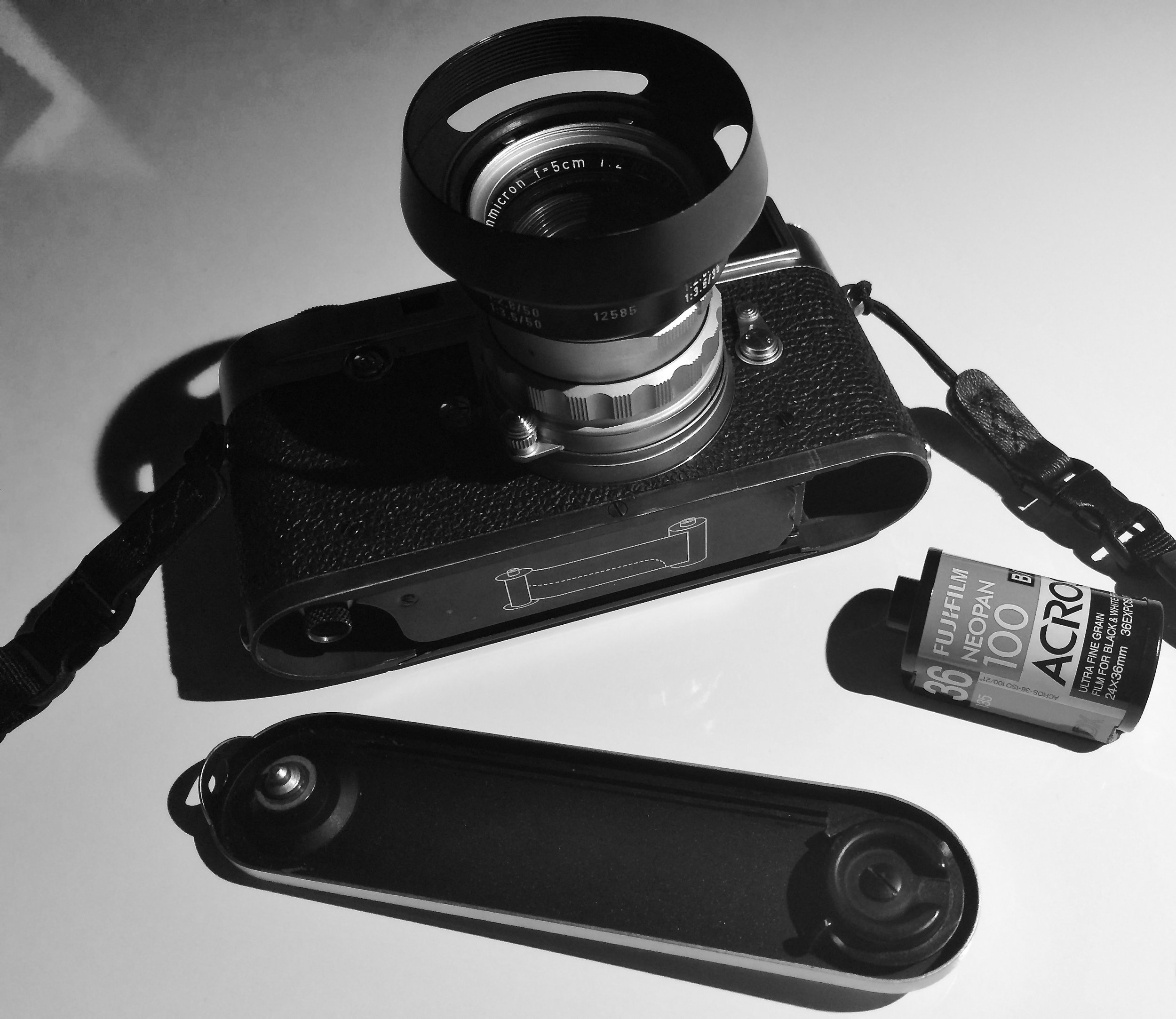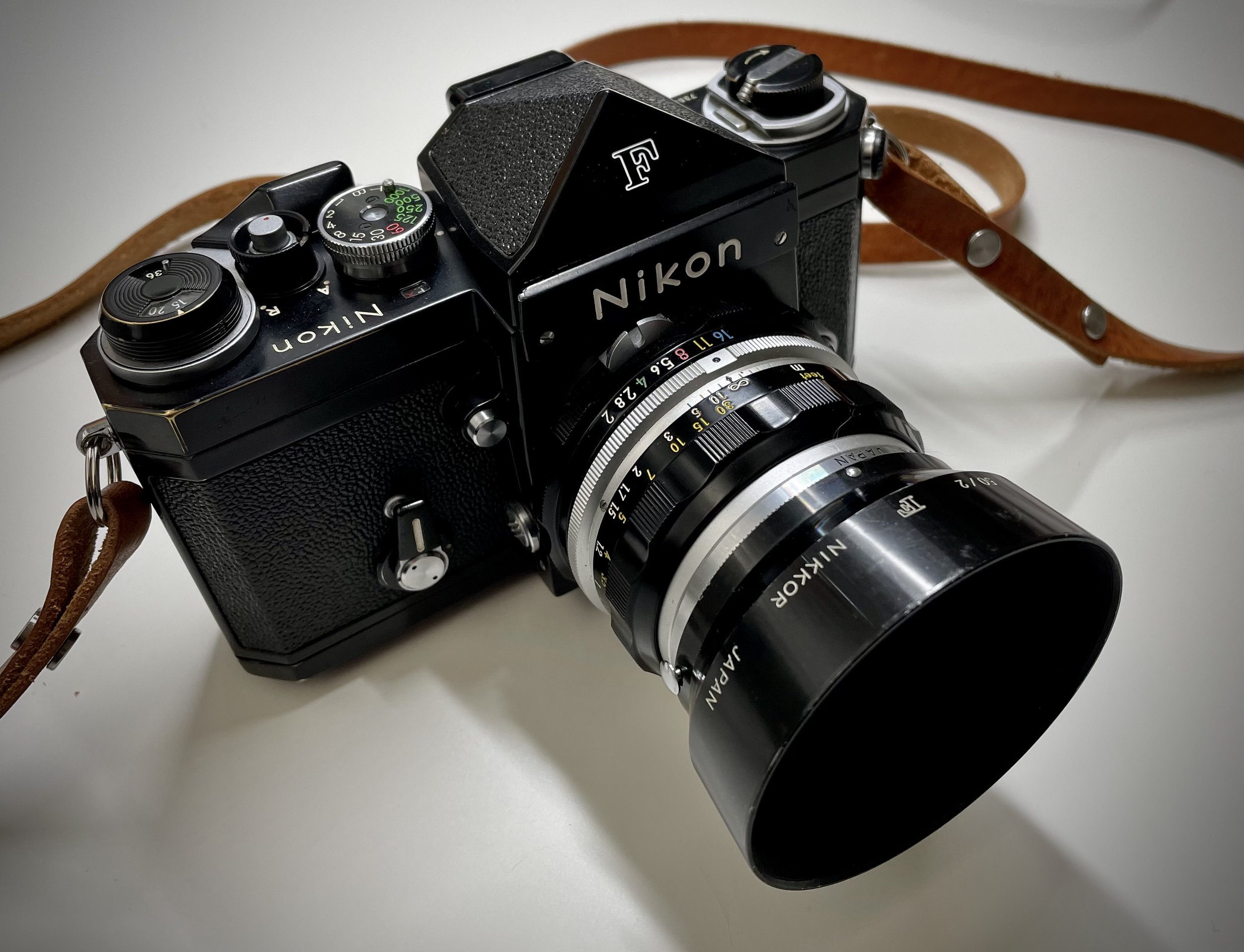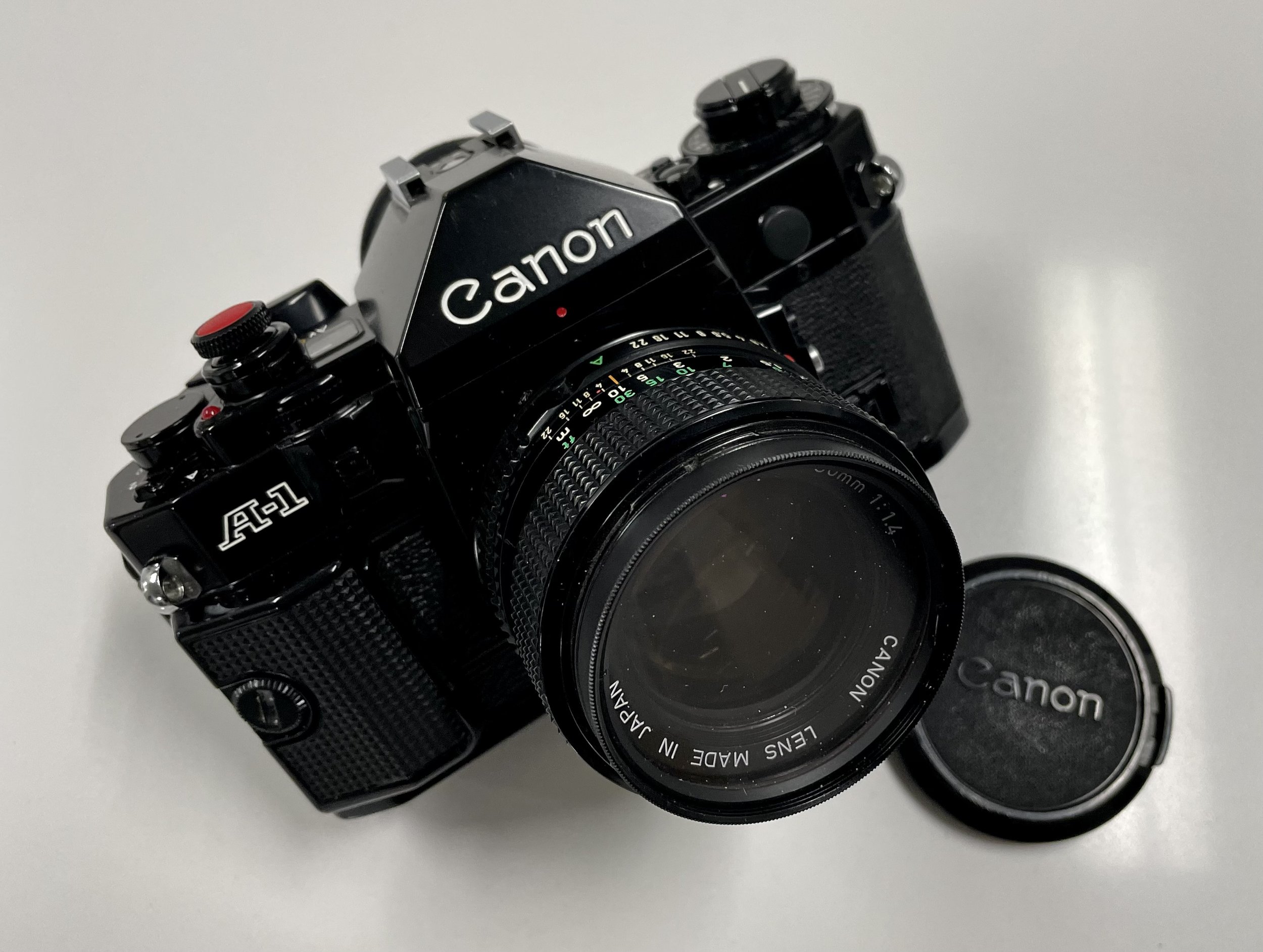Nikon FM2n, 50mm f/1.4 Nikkor, Kodak Portra 400 at 200 ISO
One Photograph: Love on the Beach
For all of the years that I lived in Bodega Bay, fall was my favorite time for long walks on the beach. While in lots of other places, the weather is getting cold and blustery, the Northern California coast is awash in warm sunshine. I got some of my favorite beach images from October through January. I shot this one in 2018 with my Canon F-1, 50mm f/1.4 chrome nose FD lens on Kodak Portra 400 exposed at 200 ISO.
I feel like the world needs a little more love right now.
Love on the Beach, Bodega Bay, CA October, 2018
Ilford HP5+
There were lots of variables in play as I tried out some Ilford HP5 Plus 400 speed black and white film. First, I am still getting used to my meter-less Nikon F camera and second, this is my first roll using a new-to-me Micro-Nikkor 55mm f/3.5 Non-AI lens.
Nikon F with 55mm f/3.5 Micro-Nikkor
With the F, I am alternating between using my Sekonic L-208 meter and Sunny 16. An article by Gregory Gross on his blog, about photography without a light meter, inspired me to try and use my eyes and my head more in determining exposure. I am enjoying the challenge.
I’ve not shot a lot of Ilford film. Most of my experience is with their FP4 125 speed film. Here’s our dog Jazz, shot Sunny 16 trying to get some treats out of her chew toy.
Our side yard gate:
One evening, a couple of glasses of cab by the fire pit. My Sekonic helped with this shot:
A glass vase on the kitchen table in late afternoon sun, best guess on the exposure.
The pentaprism of a Nikon F:
And the marquee on the theater downtown:
I’ve said for years that I want to really try and get to know one type of black and white film and use it until it becomes second nature. And learning to meter with my head is a good exercise to keep this old brain sharp.
What I really got excited about was this lens. Like the faster f/2.8 AI-s version I have, this lens is a real solid performer.
PASSED Sticker: Epilogue
A few posts back, I was debating over what to do with a gold PASSED sticker that was featured prominently on the front of the pentaprism of a lovely black Nikkormat FT2 I had just purchased and had serviced. If the sticker was anywhere else on the camera, I would have left it in place since it had already traveled with the camera for nearly 50 years. I asked my readers here and on several Facebook groups I belong to what they would do. Interestingly enough, it was about a 60/40 split with the larger percentage of people in favor of removal. But not by much.
I decided to remove the sticker. Amazingly enough, when I scuffed one corner of the sticker with my fingernail, the entire thing popped off, poof! It was surprising to me, very surprising in fact that the sticker left its nearly five decade resting place so easily. Perhaps because it knew this camera had finally found its forever home? Yeah, I’m a bit of an old camera romantic.
Some isopropyl alcohol on a microfiber cloth made fast work of the residual glue. The sticker left a faint oval on the finish of the pentaprism, which I expected. It may fade in time. It may not. I have some Rollei RPX in the camera now, a film a friend of this blog recommended I try.
One Photograph: Fine Wine
After finishing off my last roll of color print film a few weeks ago, my focus has shifted to getting more satisfaction out of my black and white photography. Looking back through some photographs, I have to admit that I was really happy with the older Fuji Acros 100 emulsion. The image above was made with my Leica M2, 50mm rigid Summicron and some Acros I bought around 2014. I like the range of tones in this image. I think it was probably because I was shooting a lot of Acros at the time and feeling inspired by the Leica rangefinder. I was using one of my handheld Sekonic meters on this day. I also miss the original Agfa 100 APX film
Right now in the fridge, I have some Tri-X, the last of my frozen Plus-X, both speeds of T-Max, a few rolls of Kentmere Pan 100, Ilford HP5+, Ilford HP4+, quite a bit of Eastman 5222 and several rolls of Rollei RPX 100 and 400. I should also give the new Acros II a try.
I am going to work my way through this stash of film, go looking for light, have some fun, polish up my skills and maybe find a film I like as much as the old Acros.
The JCII Passed Sticker: To Remove or Not To Remove
I just got my Nikkormat FT2 back from International Camera Technicians. As usual, Jim Holman did a fine job bringing this 1975 vintage camera back to factory specs.
Nikkormat FT2, Nikkor-S Auto 50mm f/1.4 Non-AI
As I mentioned in the previous post, this camera is in amazing cosmetic condition. I cannot imagine it was used much, if at all. Not a scratch or scuff anywhere. As was the case with many Japanese cameras produced from the 1950s to the mid 1980s, this camera carries the JCII PASSED gold oval sticker. JCII stands for Japan Camera Industry Institute. You will also notice JMDC below the word PASSED. JMDC stands for Japan Machinery Design Center. During this era, Japanese-made products had the reputation of being of less quality or in the case of cameras, cheap knock-offs of German designs. These stickers were an effort by Japanese companies and the government to improve their image on the world market.
I’ve had a number of cameras and a few lenses that have had these stickers in various conditions. On a Nikon F3 and Canon F-1, these stickers were on the back of the top plate, so they didn’t bother me much. My Olympus OM-1 had one on the side of the pentaprism. This is the first camera I have had with the PASSED sticker smack dab on the middle front of the beautiful black pentaprism.
Part of me wants to remove the sticker. I removed one from my OM-1n and had a devil of a time getting all of the residual glue off the camera. That was a chrome camera. Black body cameras can be a bit different. Rubbing the finish can make the paint look shiny in the spot where the sticker was. I emailed my friend Sover Wong and he said that some rubbing alcohol is good for gently removing the residual glue from the sticker, but to be gentle with the rubbing. Sover also said, if it were his camera, he’d leave it on.
For nearly 50 years, that sticker has been part of this camera. But this beautiful all black camera would sure look nice without it. What do you think? Do you remove your PASSED stickers or leave them on?
Nikkormat: The Sport Utility of 35mm SLRs
I wish I could remember where I read it so I could credit the author, but someone called the Nikkormat the “Toyota Landcruiser” of cameras. I have to admit, at first glance, Nikkormat cameras seem very utilitarian. No nonsense machines. Mechanical minimalism at its best. But after a couple of weeks of walking around with my latest camera acquisition, the Nikkormat FT3, I have to admit that these cameras are much more than they seem.
Nikkormat FT3 with Nikkor 50mm f/1.4 Ai-s lens
Nikon introduced the Nikkormat line of cameras to the world in the late 1960s as a more affordable alternative to their professional F body. Nikkormats stayed in production until 1977 when they were replaced by the smaller-bodied Nikon FM. During the era when professional photographers used the Nikon F and F2, a Nikkormat body was often in their camera bag as well, serving as a back-up.
There are several cameras in the Nikkormat series. The Nikkormat FT and FS were introduced in 1965. The FT featured full-scene averaging TTL metering. It was the first Nikon camera with a built-in light meter. The FS was the FT without a meter. The Nikkormat FTn was introduced in 1967 and featured simpler lens mounting and Nikon’s 60/40 center-weighed TTL metering. All of these early Nikkormat meters were powered by 1.35v mercury batteries. The Nikkormat FT2 was introduced in 1975 and featured the Nikon F2 plastic tip on the film advance lever and self-timer and was powered by 1.5v S76 or SR44 batteries. The FT3 was manufactured for only a few months in 1977 as Nikon had the new FM in production as well. The FT3 is similar to the FT2 except that it supported Nikon’s auto-indexing lenses. There were also several Nikkormat EL models which offered auto-exposure.
With the exception of the FT3, all of the Nikkormats that preceded it require the photographer to “index” the camera’s meter to the lens. The procedure has come to be known as the “Nikon Shuffle.” The early Nikkormats had an indexing prong on the lens mount that mates to the “rabbit ears” on Nikkor manual focus lenses. When mounting the lens, you push the prong on the camera body all the way over to the right, set the lens aperture to f/5.6, line up the prong with the rabbit ears, mount the lens and then shuffle the lens aperture all the way to the left and back to the right. This “tells” the camera’s meter what the minimum and maximum aperture is of the lens you are using. Sounds complicated but it becomes second nature to anyone who has used these pre-AI Nikon bodies. I even find myself doing it when I mount AI lenses to more modern Nikon bodies.
I found my Nikkormat FT3 at my local camera shop. I was amazed at the condition this 47-year old camera is in. I cannot find a scratch or any brassing at all on the body. It appears unused. There was a similar condition FT2 on the shelf next to the FT3. I ended up making a deal on both, two of the cheapest film cameras I have ever purchased. The FT3 functions as designed. The meter in the FT2 was dead. I sent it to Jim Holman at International Camera Technicians. It is repaired and on its way back to me as I write this. Turns out the meter issue involved some wiring in the battery compartment and meter contacts that required cleaning.
While I was waiting for my FT2 to return from the shop, I spent some time with the FT3. When I mentioned earlier that the Nikkormats were marketed as less expensive alternatives to the F professional bodies, it is still very apparent that these cameras were from an era where hand assembly and inspection were the norm. Fit and finish is extraordinary. No planned obsolesce here, all metal, glass, levers and springs. The Copal Square vertically traveling focal plane shutter sounds amazing and very strong. The camera feels great in the hand, inspiring you to want to get out and take pictures.
One of the things I love about the Nikkormat is the big film frame counter. I find I need to grab my reading glasses to see what frame I am on with most cameras. Not the Nikkormat.
Big, beautiful film frame counter
A weird ergonomic quirk on these old Nikkormats is the placement of ASA and shutter speed controls. You’ll notice they are not on the top plate as is the case with most SLRs of this era. Similar to the Pentax K2, these controls are located on the lens mount. Here is the ASA setting:
And here is the shutter speed setting:
I found the Nikkormat’s lens mount ASA and shutter speed setting much easier to manage than my Pentax K2. The shutter speed control has a tab on the left side of the lens mount which makes adjusting speeds easy with the camera to your eye. The FT3’s viewfinder is big and bright, with shutter speeds visible at the bottom of the frame. Meter display is a simple, center-the-needle affair. The FT3 has Nikon’s nifty K screen with split-image focusing. One very cool feature is the additional metering display on the top plate of the camera.
I loaded some Kodak Ultramax 400—the very last roll of color film I had, in the FT3. Here are a few test shots from a bright day out at the coast.
And a few from an afternoon of wine tasting.
A friend of mine has an old Landcruiser with several hundred thousand miles on it. It screams utility but in a very refined way. Comfortable, dependable, capable, built to last. Much like the Nikkormat.
I am anxious to get the FT2 back from service. It will be interesting to compare the serviced FT2 with the FT3. And I have a number of nice non-AI Nikkors that will mate nicely with it.
If you are looking for a very capable 1970s vintage SLR, I would heartily recommend the FT2 or FT3 Nikkormat. FT2 prices start at $25. FT3 prices $50 and up. FT and FTn models are even cheaper, but you’ll have to shoot them with an external meter, Sunny 16 or pay a technician to modify them to take modern batteries. The Wein cell is an option too, but I’ve not used one.
My Zen Place
At least weekly, sometime more often, I’ll pick up one of my film cameras sans film and cycle it through its shutter speeds. I used to tell myself that the reason I was doing this was to exercise the shutter and keep all of the moving mechanical parts operating in good order. And of course, it is important to use a machine regularly. Lubricants dry out. Mechanical cameras do not like to just sit on a shelf. But I have to be honest with myself and with you. There’s something cathartic, meditative and zen-like about cocking the shutter, focusing on the table lamp across the room and firing off a few shots at 1/30th, 1/60th, 1/125th of a second. At least for me.
Analog photography is full of delightful tactile experiences. Like loading a roll of 120 film into a Hasselblad film back…
Calculating exposure with an old Weston meter…
Winding film onto a stainless steel developing tank…
Feeding a new roll into a Leica…
I remember talking to a friend many years ago who enjoyed woodworking. He built very nice pieces of furniture however he told me that he enjoyed working on the piece more than the joy of having it completed. The tools, the process, the sounds, even the smell of wood was what he truly enjoyed…his zen place. I guess that is true for me as well. The tools and the process bring me joy, whether there’s film in the old Nikon or not.
Madness
I knew when I saw the black Nikon F Apollo in the case at my local camera shop on my lunch hour that I would go home that day with a lighter wallet. I’ve recently become quite infatuated by the F bodies with the standard non-metered finders and this 1972 vintage example looked to be in fine shape. In these days of escalating film camera prices, Nikon’s original SLR is still somewhat of a bargain. I asked to see the camera and quickly ran it through all of its shutter speeds. The finder seemed clean and clear with no de-silvering. Removing the back, the film chamber looked very nice, the film advance was smooth and sure. In short order, the old Nikon was in bag next to me in the car as I headed back to the office.
I know buying another old camera sounds like madness if you’ve read my recent posts where I talk about reducing my collection, but there really is a method to all of this. There is. Really. My plan is to whittle my collection down to just a few cameras that inspire me to get out and take more pictures and it seems that after all of these years, minimalist, mechanical machines seem to do that for me. As for the F, I wanted a chrome one and a black one. I already owned a chrome one so…ok, maybe it is madness.
I think, maybe a little too much, about these old cameras that find their way into my life. This particular F is over 50 years old and in very good condition. The body is cosmetically probably an 8.5. There’s a little brassing on the top plate and some surface scratches on the bottom. The finder is nearly mint, which makes me think that at some point, someone switched out an older Photomic finder for this one. I wondered who owned this camera and how, after all of these years, did it end up on a glass shelf in a camera shop in Northern California?
I decided that this old F deserved a spa day and reached out to my friend, Nikon F2 guru Sover Wong, to see if he might take in my F for a refurbishment. Sover only works on F2 bodies but graciously offered to make an exception and service my F.
Having a camera serviced by Sover Wong is an immersive experience. From the moment he opens up your camera for inspection, he sends pictures and updates. Sover’s first email to me thankfully did not contain any surprises:
The camera had not been opened or serviced before
There was original old glue on the front leatherette coverings
Foam seals were old and rotten
Mechanisms were dry
Slow speeds were good, fast speeds needed adjustment
The inside was very clean with no corrosion or fungus
Here is the photo of my F, opened for inspection:
Sover cleaned and lubricated all of the mechanisms, replaced the rotten foams, cleaned the mirror, adjusted the shutter speeds and returned the F to factory specs. Next, he inspected the prism finder:
The finder had rotten internal foams with fungus
I asked why the camera body had no fungus and the prism finder did. He replied that fungus is very common in F and F2 standard prism finders as they have no ventilation and are very dark inside. Fungus loves that kind of an environment.
Here are some pictures of my finder with the icky fungus:
Servicing the finder, Sover removed all of the old rotten foams, cleaned all of the surfaces and optics and applied new foams. He also added a Nikon F2 protective cover inside the prism. Here is a shot of the prism finder with new foams and prism protective cover:
I was quite surprised to receive my camera back from Sover four days after it was shipped from the UK. I sent a birthday card to my Mom once and it took two weeks to get from California to New York. As many people have written, receiving a camera back from a Sover Wong service is like getting a brand new camera. A properly serviced mechanical camera is a delight!
Here is my serviced Nikon F Apollo with a Nikkor 50mm F/2 lens, lens hood and my favorite Eggleston leather strap:
I have some Ilford HP5+ film loaded in the F as I write this. As you can see from the photo, I’m about halfway through the roll. I will share the results soon.
I believe I have a clear vision of my photographic workflow moving forward—Simple, mechanical film cameras loaded with black and white film and my Fujifilm X-T1 mirrorless digital camera for color work and also as a platform for some of my older legacy lenses with adapters.
I see myself with just a few cameras. Maybe two or three...or four.
Really.
One Photograph: The Golden Gate from Tiburon
I’ve lived in the Bay Area for nearly 14 years now and have not spent much time at all in the little community of Tiburon. Just across the Bay from San Francisco, Tiburon is an upscale community with a quaint little downtown area. My wife and I spent a night there a few months ago and I took along my Nikon FE loaded with some Ferrania P30 film. I’ve not shot much P30…I think this is only my second roll…so I am still deciding if I like it or not. Nonetheless, I do like this photograph I made of my wife taking a photo with her iPhone as the Golden Gate Bridge emerged from a fog bank.
Downsizing Update
This blog has rewarded me with some enriching connections with photographers in the US and around the world. I feel very fortunate to be part of an analog film community that is vibrant and healthy.
Last month, I listed six film cameras that I am selling in order to downsize my collection to just a few cameras that I regularly shoot. I sold three of the six to friends of the blog. I feel good that these cameras have gone to good homes and it will be fun to see the photos they shoot with them.
Here are the three that remain, all with price drops. Any of these would be great for someone just discovering film or for seasoned shooters as well.
Pentax K2 with 50mm f/1.7 SMC Pentax-M
Pentax K2 with 50mm f/1.7 SMC Pentax-M: The K2 was the top of the line in the K series full size Pentax SLRs. Think KX, KM or K1000 with aperture-priority auto exposure. I love the analog meter read out in the viewfinder. This copy came from a dear friend in Los Angeles who used to work for Pentax. Overall in excellent ++ condition. Lens is in similar condition. I’ve included an after-market lens hood as well. $200 + shipping.
Canon A-1 with Canon FD 50mm f/1.4
Canon A-1, 50mm f/1.4 Canon FD: Jim Holman at ICT in San Diego did a complete CLA on this A-1 last March which cost $180.55. I’ve shot it twice since then, hence my desire to see it in the hands of a friend, making amazing photos. The A-1 was the top of the line of Canon’s A-series cameras when it was introduced in 1978. It offers four exposure modes: Manual, shutter-priority, aperture-priority and a program mode where the camera does all of the work for you. I’ve tried many times to fool the meter in this camera and have never been successful, it’s that good. The information display in the viewfinder is unique to this camera with bright red shutter speed and aperture. The 50mm lens is a stellar performer. Camera comes with lens, cap and an after-market red soft release that I think looks cool. SOLD
Nikon FM2n
Nikon FM2n Black Body: I had Bellamy Hunt, the Japan Camera Hunter source this FM2n for me. Other than the FM3a, which I could never afford, I think he FM2n is Nikon’s most amazing all mechanical camera. With a top shutter speed of 1/4000th of a second and Nikon’s dependable center-weighted metering, there is really nothing this camera cannot handle. This is a camera that you can buy, shoot for a few years and then sell and probably get back what you paid for it. SOLD
Considering Color
I shot the last roll of color film I had on hand this past weekend. It was Kodak’s ColorPlus 200 which I bought for about nine dollars earlier this year. I like ColorPlus, but not as much as I like Portra 400. I’ve made some of my most satisfying color photographs on Portra 400, setting my camera to meter at 200 ISO to coax a little more sizzle out of the film.
Portra 400 sells for about $15 a roll as I write this and I think that is a lot. Processing and scanning costs another $15. That’s nearly a dollar a frame!
I see that Kodak’s Pro Image 100 is available again for $8.99 a roll and I like that film, but not as much as Portra. Fujicolor 200 is about the same cost. It’s just me, but I like the flexibility of 400 speed color film.
Right know, I am pondering using my Fujifilm X-T1 digital camera for color photography and shooting black and white exclusively in my film photography. I have a nice supply of Kodak Tri-X, T-Max, Plus-X and Ilford in the chiller. Maybe by the time I shoot that up, color film prices will come down a bit. If not, I’ll be content with monochrome analog photography.
The author shooting Portra 400 in his Olympus OM-2, Marin County, CA.
The image on Kodak Portra 400
KLRB-FM, Carmel, CA circa 1977. Image courtesy of Bob Stock and KLRB
Late Night Radio
I just read an article about a radio station using an AI-generated disc jockey. It got me thinking about how lucky I was to work in radio when it was still live, local, very analog and very fun.
From 1978 to 1983, I worked at various small town stations in Upstate New York and finally in Phoenix, Arizona. In those days, radio stations had live disc jockeys covering most every hour of the day. DJs usually worked four hour “airshifts”; 6:00am to 10:00am was morning drive, 10:00am to 2:00pm was mid-day, 2:00pm to 6:00pm was afternoon drive. Evening and overnight shifts were longer. At one station I worked for, afternoon drive was 3:00pm to 7:00pm and the evening shift was from 7:00pm until 1:00am when the station signed off the air. For 24 hour a day stations. overnights were typically from midnight until 6:00am.
I never did morning or afternoon drive, but I worked mid-days, evenings and overnights. While it was great working at the station during the day when the place was a buzz of activity, I must say that I enjoyed the evening and overnight airshifts most of all. The station had a different vibe after the sun went down, cooler, hipper, more relaxed…more romantic. I was a bit of a loner in those days and the solitude of being by myself in the broadcast studio in the wee hours suited me.
One common misconception about being a disc jockey was that you got to play whatever music you wanted to play. In most cases, that is not true. Radio stations had a Program Director or Music Director who “programmed” the station. The radio station’s “playlist” was carefully designed to match the demographics of the station’s listeners and to get them to listen often and for as long as possible. The more people who listened and the length of time they listened directly correlated to how much money the station could make from advertising. All of the stations I worked at had a “format” or “daypart” clock that told us what songs to play in each segment of the hour, when to stop for commercials, weather or news. If everyone followed the clock, the station sounded tight and consistent all of the time. Evening and overnight jocks got a little more leeway. We could play longer cuts of music and mix in more obscure cuts, depending on the format of the station. As a nighttime jock, you could get away with not following the clock or “breaking format” much easier than the people on the air during the day could. At one station I worked at part time in Arizona, I was breaking format like crazy one night around 2:00am and it just so happened that the Program Director was on his way home from a night out and heard me. He called and told me how great I sounded. I was lucky and he was probably drunk.
Radio stations had “request lines”, a telephone number that listeners could call in to make requests. The number rang through to a phone in the studio. A little blinking light told the disc jockey that someone was calling the request line. One would think that people calling a radio station in the middle of the night might be odd, but in all the time I worked evenings or overnights, I never had a “Play Misty for Me” moment. Most of my callers were very nice people working third shift at IBM, nurses at the local hospital, people working at 24-hour diners, security guards and the like. I think the oddest call I ever got was when I was working at an album rock station and some guy would call each night and when I answered, he would simply say in his best Jeff Spicoli voice… “FREEBIRD” and hang up, obviously asking for the Lynyrd Skynyrd hit.
Clint Eastwood in “Play Misty for Me, 1971. The Malpaso Company, Universal Pictures
Some of the stations I worked at carried live network news, usually at the top of each hour. In those days, you had the ABC Radio Networks—American Information, American Contemporary, American Entertainment and American FM, CBS Radio, NBC Radio and Mutual. If you worked at a station that carried network news live, you had to learn how to “back time”, making sure that your song ended with enough time for a station ID, jingle, promotional announcement or whatever and it all ended just perfectly before the news started. Doing it right took a little math and a lot of practice, but when you did it right, it was very satisfying.
Back timing was also used when disc jockeys “talked up” record intros. This was an art and the best jocks would talk over the intro of the record and “hit the post”, saying their last word just as the vocals of the song started. You can hear what I mean by checking out some classic radio airchecks on YouTube from WLS Chicago or WABC New York to hear top 40 DJs like John Landecker, Tom Kent and Dan Ingram hitting the post on the hits of the day.
40 years ago radio was an important part of everyone’s life. People depended on it for entertainment, news and information. Working in local radio was fun and rewarding, even in the middle of the night. Today, locally owned and operated stations are far and few between and if you hear a disc jockey on one of the corporate-owned stations, chances are he or she is “voice tracking” for multiple stations across many markets. Or it might not even be a real person at all.
One Photograph: Found Faucets
For 6 months or so, in 2013, I rented a little cottage on Salmon Creek just off the Bohemian Highway in Freestone, California. The Freestone cottage sat on about an acre along the creek, mostly in the shade of oak and redwood trees. Shafts of sunlight would poke down through the canopy providing me interesting light to play with at all times of the day. In the sunny spots, apple and pear trees flourished.
In addition to the cottage, various businesses operated from the property over its long life. Freestone was originally a lumber town and I was told that the old foundation near the back of the property was once a blacksmith shop to serve the nearby stagecoach line. Near the creek, I found the remains of a large brick oven.
One of the most interesting features of the property to me were the outdoor faucets. They were everywhere! A few of them, closer to the cottage, worked. Most did not. I was shooting a lot of medium format while I lived at the Freestone cottage, mostly my Hasselblad 500cm and Mamiya 645Pro. As I wandered the property with my cameras, some of these found faucets became subject matter.
Two faucets, Freestone, CA, Mamiya 645Pro, Kodak Ektar 100
Downsizing
I am beginning to downsize my collection of film cameras and regretfully parting ways with a few that I do not shoot enough. They need to go to good, loving homes. If you have followed my blog for any length of time, you know I go to great lengths to find nice cameras and then invest in a service if necessary. These are all nice cameras and ready for you to enjoy.
If anything interests you, please contact me. Prices do not include shipping and in most cases, everything will fit well in a USPS Priority Medium Flat Rate for about $18 shipping cost in the US.
Nikon FM2n Black Body: Excellent +++ condition. 1/4000th of a second in a fully mechanical marvel. Lens not included but I can kit you out if you want. $425
Pentax K2 with 50mm f/1.7 SMC Pentax-M Lens: Excellent ++ condition. Includes OEM UV filter and after-market lens hood $205
Nikon F Chrome w/eye level prism and 50mm Nikkor-H Auto f/2 non-ai lens: Nice condition Nippon Kogaku logo version. SOLD
Canon A-1 with 50mm f/1.4 Canon FD Lens: Recently CLA’d. Excellent ++ condition with Canon UV filter and red soft release. $265
Nikon F100 with 50mm f/1.8 Nikkor AF-S special edition lens: Like new condition. SOLD
Nikon FE Chrome: Excellent ++ condition, fully CLA’d. SOLD
Canon F-1n, 50mm f/1.4 Canon FD lens on Kodak's Tmax 100.
One Photograph: Solitude
Living on the Sonoma coast for so many years provided ample opportunities for late afternoon and evening walks on the beach. I’d often take one of my old cameras along and, if I got lucky, grab a shot or two during those magic moments just before the sun slipped below the horizon.
Busy on the weekends, the stretch of sand near where I lived was uniquely quiet on weeknights. Sometimes, I would only pass one or two people enjoying the sounds of the ocean and the solitude.
Some of my most satisfying images have been of people walking the beach, silhouetted against the disappearing daylight. I always felt as if I were intruding on their privacy as I made these shots. I felt uneasy, but told myself that if a subject asked, I would simply say I was photographing the sunset over the ocean.
No one ever asked.
One Photograph: Rainy Day
Watching the news coverage this week of the wet weather in Southern California reminded me of a particualry rainy February back in 2015. We had several weeks of big storms with lots of rain and wind. I was living out at the coast in Bodega Bay at that time and one Saturday morning, I woke to a downpour and a power outage. With the electricity out, I had to make my coffee that morning on a small camp stove, standing outside under an overhang.
All day long, I was really itching to go outside, get some exercise and take some pictures, but coastal storms are no fun for people or cameras, so I spent the day inside with my Nikon F2, some TMax 400 film and the fabulous 55mm f/28 Micro-Nikkor lens.
Standing at the window, hoping the storm would let up even for a short while, I snapped this photo that pretty much summed up the mood of the day.
One Photograph: The Fences at Fort Ross
The Pacific Coast Highway between Bodega Bay and Fort Ross is not for the faint of heart. The road barely seems to hang on to the cliffs here and sometimes pieces of it give up and fall into the ocean. More than once, in my decade of living on the coast, I’ve driven this route and found the ocean side lane closed and passage limited to one lane. It’s a driver’s road for sure, the journey being as much of a reward as the destination.
Fort Ross, an active fort from 1812 to 1842, was the southern most settlement in the Russian colonization of the Americas. Today, it is a state historic park. I try and visit at least once a year, not so much for the history, but to spend time along this stunning stretch of Northern California coastline and make some photographs.
There are miles and miles of deteriorating wooden fences in the park. I came across this section that seems to almost slip over the edge and go into the Pacific. I made this photograph with my Nikon F4, 50mm f/1.4 AF-D Nikkor on Kodak Portra 400 with the camera set at 200 ISO.
Facebook Flips
I finish off most every roll of film I shoot by taking a mirror selfie. It’s my system for remembering which camera and lens I used. I have shared these self portraits here and occasionally on various Facebook groups I belong to, mostly to show off a camera. More times than I can count, someone in the group will download the photo, put it into Photoshop, flip it and re-post it. At the very least, someone will comment “Why don’t you flip this image so we can read the name of the camera correctly?”
I’ve done post processing of my photographs since I started in photography. Manipulating images in the darkroom was time consuming, but fun. Photo software makes it much easier. Whatever a photographer wants to do to their own image to fully express his or her vision, I say “have at it!” But please leave mine alone. I think a mirror selfie should look like a mirror selfie. And in this case, you spell it n-o-k-i-n.
Minimalist Photography
I’ve joined a Facebook group of photographers who embrace minimalism in photography. Browsing through the posted images, there are quite a few that I really like. I have never considered myself one type of photographer or another, but in looking through many of the photographs I have made, I realize that some of my most minimalistic images are the ones that satisfy me most.
Windmill, Mendocino CA. Leica MP, 35 Summicron, TMax 100



